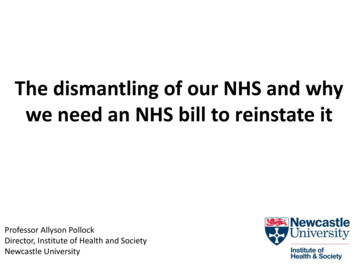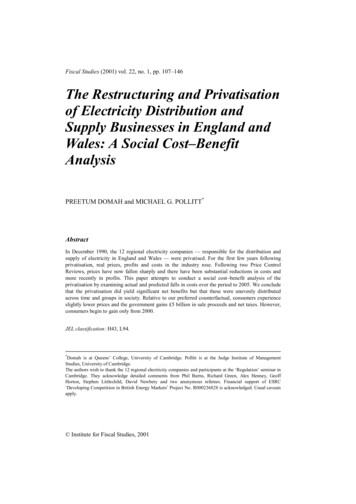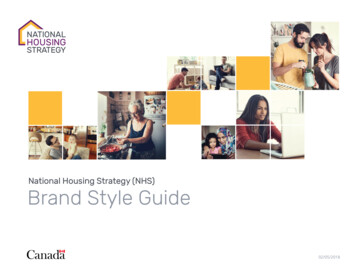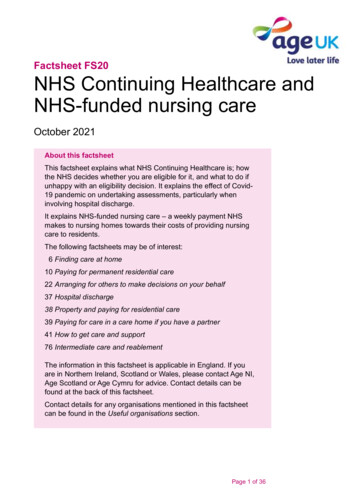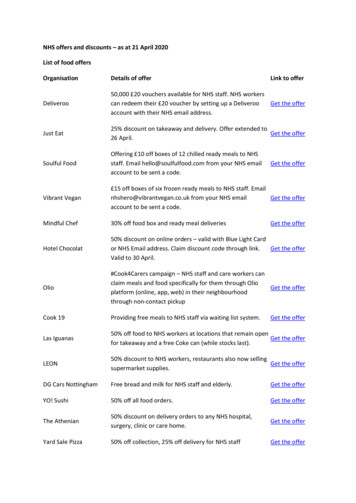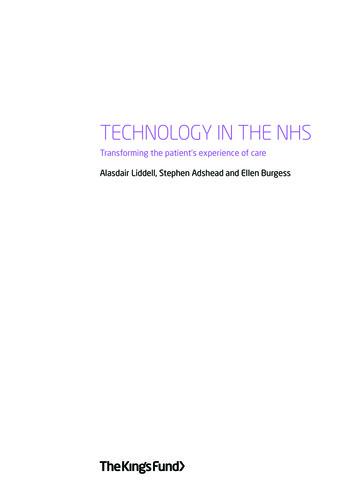
Transcription
Privatisation in the English NHSImplications of Covid-19Sarah Reed, Senior Fellow, Nuffield TrustTwitter: @sjanereed
Reflections
Areas for potential expansion Nature of anti-competitive behaviour – how does this manifest ineach category of the framework described? Differences across countries of UK – how do the agreementsreached in Wales differ? Context and history of the NHS’s relationship with the privatesector – how has this relationship evolved over time, and what havethe implications been for policy? Further implications of Covid-19 – what might this evolvingrelationship with private sector mean for providers and patients, andwhich services most likely to be affected?3
Overview Background and context – What does‘privatisation’ look like in the NHS and howhas this evolved? What has changed under Covid-19, and whereare there unknowns? How does the UK experience compareinternationally?4
Background and context
A thorny issue 6
British public tend to prefer a‘publicly run’ health service7
While privatisation is divisive,headlines can be misleading British Social Attitudes Survey of 2014 found that 43% of thosepolled don’t have a preference for whether their NHS-funded care isdelivered by NHS or another private providers But far fewer (16%) said they would prefer to treated by a privateprovider than an NHS one (39%) 8
How much of the NHS isprivatised?9
How much does the NHS buy fromprivate sector? In 2018/19 22% of the Englishhealth spending goes toorganisations that are not NHStrusts or other statutory bodies. 7.3% on independentsector providers Figure most frequentlycited by DHSC, but canbe misleading
How much of British healthcareis privately financed?11 Government expenditure onhealthcare accounted for 79%of total current healthcareexpenditure in 2017. Largest share of privateexpenditure comes from OOP(16%), followed by voluntaryhealth insurance (3%)
How and why has this changedover time?NHS-purchased, privately delivered Drive to increase competition in the provision of care since 1990s. Focus on patient choice and improved access Health and Social Care Act 2012 – increased number of contracts toprivate providers, but not overall spending in private sector Mental health and community services have seen quickest increases.12 Contracts retendered most frequently in these areas? Larger number of private / non-NHS providers?
How and why has this changedover time?Privately funded, NHS-delivered Health and Social Care Act 2012 lifted cap on private patient incomein NHS to 49% 13Income from private patients in NHS has not changedsignificantly since lifting of cap ( 1% of overall providerincome since 2011/12).Exceptions in some trusts, particularly London hospitals with longtraditions of treating overseas patients
Impact of Covid-19A new relationship with private health care?14
NHS-purchased, privatelydelivered care: what changed? Private hospital capacity requisitioned by government “Buffer capacity” to deliver essential procedures throughoutCovid-19 Maintaining as “clean” non-Covid sites to reduce backlog andwaiting lists Newly announced training partnershipHealth and care voluntary sector particularly hard hit by Covid-1915
NHS purchased, privatelydelivered care: open questions Challenges of capacity going into the pandemic may make anongoing relationship with independent sector key part of recovery But to what extent will ongoing relationships with independent sectorresult in additional capacity? How will an expanded relationship with independent sector impactquality, efficiency and equity across services? How will procured services compare to previous years in terms ofpatient needs, preferences, etc.?16
Privately funded, NHS-deliveredcare: what happened? Reduction in private work throughout Covid-19 (due to requisitionedservices, and restrictions on non-urgent care)17 84% reduction in episodes of privately funded care at heightof Covid-19 pandemic compared to previous year Insurer-funded oncology activity returned to pre-pandemiclevels in June, but overall private health activity remained at47% of the same period in 2019.
Privately funded, NHS-deliveredcare: open questions Will private access be reduced as NHS continues to useindependent sector facilities and capacity? What impact will longer waiting times have on demand for privateinsurance? Will NHS trusts reliant on private income be able to maintain thisrevenue?18
International experiencewith the private sectorduring Covid-19
The international picture 21Many countries also turned to private sector to increase testing capacity,add extra hospital beds, equipment, or health care workers (as inFrance, Germany, parts of Italy) Many countries have secured a cost price for additionalcapacity to avoid excess profits Other countries (Australia, Spain, Ireland) took similarapproach to England and ‘block booked’ capacitySome countries continue to work with private sector to increasecapacity as part of recovery - as in Italy, Spain, Austria, Canada andGreece
Conclusion
www.nuffieldtrust.org.ukFollow us on Twitter – twitter.com/NuffieldTrustSign up for our newsletter – www.nuffieldtrust.org.uk/newsletter-signup
Sarah Reed, Senior Fellow, Nuffield Trust Twitter: @sjanereed Privatisation in the English NHS Implications of Covid-19


